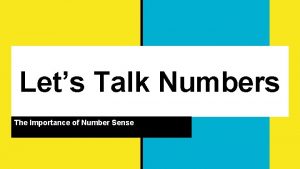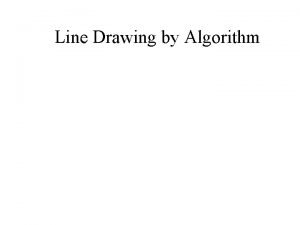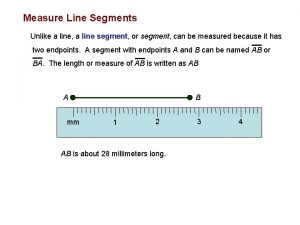Introduction to LIN E Line The path of















- Slides: 15

Introduction to LIN E

Line The path of a continuous, moving point through space. Line is important to an artist because it can describe and identify shapes.

TYPES OF LINES ACTUAL LINE May vary greatly in weight and character -Expressive Lines -Descriptive Lines IMPLIED LINE Created by positioning a series of points so that the eye tends to automatically connect them—not actually drawn! By using the various types of lines, artists have the potential to lead a viewer’s eye through a composition.

ACTUAL LINE Expressive Lines that communicate ideas & moods. VERTICAL HORIZONTAL DIAGONAL CURVED ZIG-ZAG

ACTUAL LINE EXPRESSIVE LINES continued Vertical Lines Stability & Strength

ACTUAL LINE EXPRESSIVE LINES continued Horizontal Lines Calm & Peaceful

ACTUAL LINE EXPRESSIVE LINES continued Curved & Zig-Zag Sense of activity, tension, & even confusion

ACTUAL LINE EXPRESSIVE LINES continued Diagonal Lines Movement or instability

VARIATIONS OF LINE QUALITY TEXTURE With the combination of various line types, a multitude of possible effects can be created.

ACTUAL LINE DESCRIPTIVE LINES Lines that DESCRIBE how an object looks. Contour Gesture

DESCRIPTIVE LINES CONTOUR LINES Line used to follow the edges of forms, to describe their outlines and inner details. This is the most common use of line in art. Contour lines describe the wrinkles &folds in your clothes.

DESCRIPTIVE LINES GESTURE LINES Quick, sketch-like lines Your drawn lines don’t stay at the edges but move freely within the forms. You are more concerned with capturing the ACTION rather than drawing accurately. It captures the movement of the subject rather than recording the details of the form.

EXAMPLES:

EXAMPLES:

EXAMPLES:
 Unity iot
Unity iot Adjustable cross staff in surveying
Adjustable cross staff in surveying The path of a moving point.
The path of a moving point. Let's talk numbers meaning
Let's talk numbers meaning Hình ảnh bộ gõ cơ thể búng tay
Hình ảnh bộ gõ cơ thể búng tay Ng-html
Ng-html Bổ thể
Bổ thể Tỉ lệ cơ thể trẻ em
Tỉ lệ cơ thể trẻ em Chó sói
Chó sói Tư thế worms-breton
Tư thế worms-breton Hát lên người ơi
Hát lên người ơi Các môn thể thao bắt đầu bằng tiếng đua
Các môn thể thao bắt đầu bằng tiếng đua Thế nào là hệ số cao nhất
Thế nào là hệ số cao nhất Các châu lục và đại dương trên thế giới
Các châu lục và đại dương trên thế giới Công thức tính thế năng
Công thức tính thế năng Trời xanh đây là của chúng ta thể thơ
Trời xanh đây là của chúng ta thể thơ




























